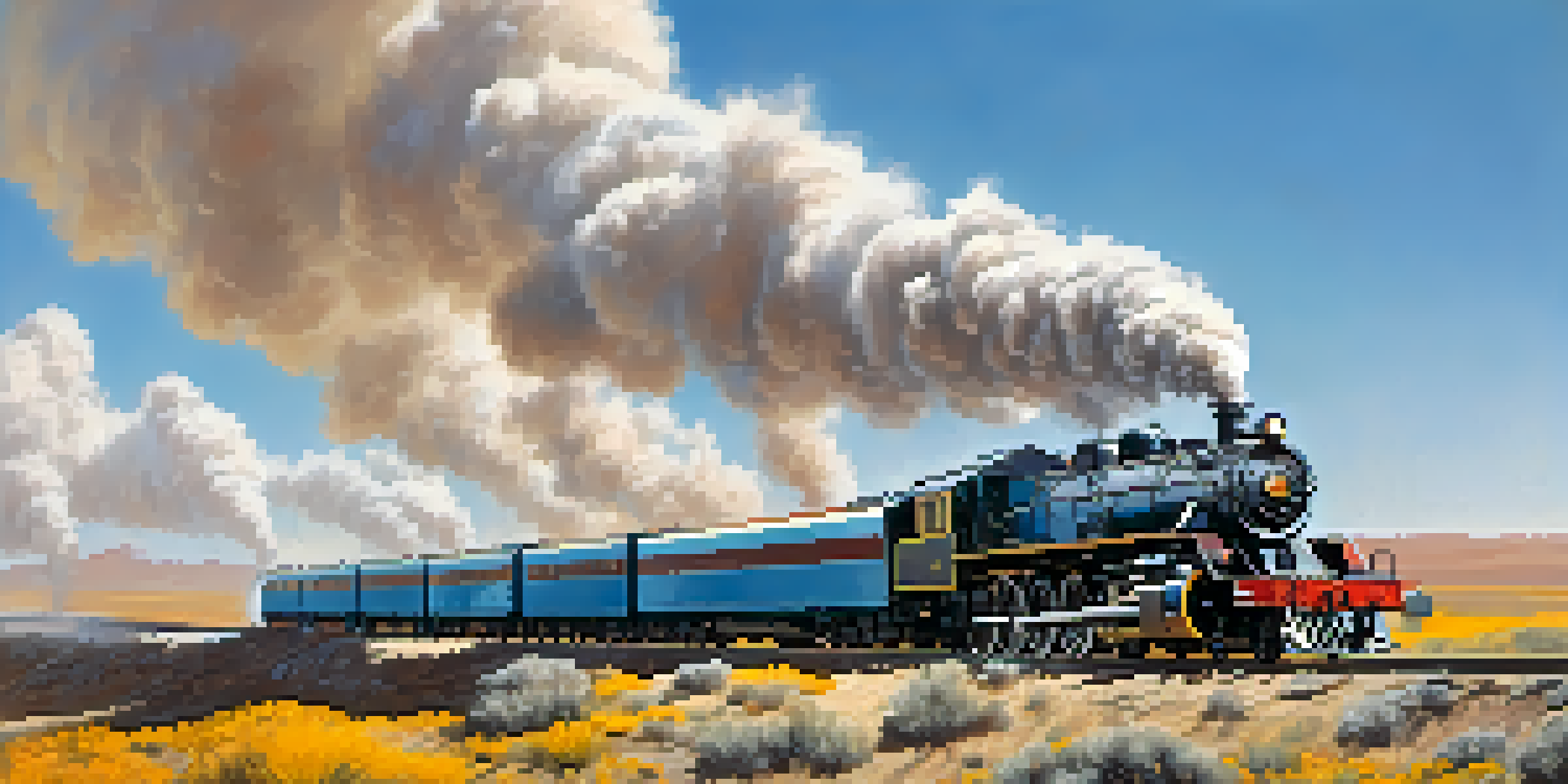The Transcontinental Railroad: A Catalyst for Growth

Introduction: The Birth of a National Infrastructure
The Transcontinental Railroad, completed in 1869, marked a pivotal moment in American history. It connected the East and West coasts, facilitating travel and commerce like never before. This monumental achievement not only showcased engineering prowess but also set the stage for nationwide economic expansion. Imagine a time when a journey across the country took weeks; the railroad turned that into a matter of days, fundamentally altering how Americans lived and worked.
The railroad is a great and powerful engine, and its power is in the hands of the people—the power to unite and to create.
Before the railroad, the vast distance between states posed significant challenges for trade and communication. Goods and services were often delayed, impacting local economies. With the railroad, the movement of products became faster and more efficient, allowing businesses to thrive and consumers to access a wider variety of goods. This newfound connectivity stimulated the growth of markets across the nation, laying the groundwork for a unified economy.
In essence, the Transcontinental Railroad was more than just tracks and trains; it was a symbol of progress and innovation. This infrastructure project united a divided nation and opened up opportunities for countless individuals. As we delve deeper into its impact, we’ll see how it spurred growth in various sectors, reshaping the American landscape.
Economic Expansion: Fueling Trade and Industry
The completion of the Transcontinental Railroad unleashed a wave of economic activity. It allowed for the rapid transport of raw materials to factories and finished goods to consumers. This efficient movement of goods not only lowered costs but also encouraged manufacturers to expand their operations. For example, industries such as steel and agriculture flourished, as they could now easily reach new markets beyond their localities.

Moreover, the railroad spurred the growth of new towns and cities along its route. These burgeoning communities became hubs of commerce, where businesses sprang up to cater to the influx of travelers and goods. This urbanization created jobs and attracted immigrants seeking new opportunities in the expanding economy. Each new station along the track became a lifeline for entrepreneurship and innovation, contributing to the overall prosperity of the nation.
Economic Growth Through Connectivity
The Transcontinental Railroad revolutionized trade by enabling the swift transport of goods, which stimulated economic expansion across the nation.
The ripple effect of the railroad's impact on trade and industry is evident even today. It laid the foundation for America's industrial revolution, which would further elevate its status as a global economic power. By facilitating the movement of goods, the Transcontinental Railroad transformed the way business was conducted, creating a vibrant marketplace brimming with possibilities.
Cultural Exchange: Bridging Diverse Communities
The Transcontinental Railroad not only transformed the economy but also played a crucial role in cultural exchange. As people traveled across the country, they brought their customs, ideas, and traditions with them. This movement fostered a greater appreciation for diversity, as individuals encountered different ways of life. The railroad acted as a bridge, connecting various cultures and promoting understanding among them.
The Transcontinental Railroad was a tremendous achievement, bringing together vast distances, and changing the landscape of America forever.
Additionally, the railroad facilitated the migration of various groups, including immigrants who sought new beginnings in America. They settled in towns along the route, enriching the local culture with their unique perspectives and experiences. Such interactions helped shape a more inclusive society, paving the way for future generations to embrace multiculturalism. The blending of cultures led to innovations in arts, cuisine, and community practices.
In essence, the Transcontinental Railroad was a catalyst for cultural unity. By connecting people from different backgrounds, it nurtured a sense of shared identity among Americans. This cultural exchange not only enhanced social cohesion but also contributed to the rich tapestry that defines the nation's character today.
Innovation in Transportation: A Model for the Future
The construction of the Transcontinental Railroad was an engineering marvel that set new standards for transportation. It introduced advanced techniques in railway construction, such as the use of steel rails and specialized locomotives. This innovation not only improved safety and efficiency but also inspired future transportation projects across the globe. The railroad became a blueprint for modern infrastructure development.
As trains became faster and more reliable, they spurred advancements in related industries, such as manufacturing and logistics. The need for specialized train cars and improved signaling systems led to further technological innovations. For instance, the introduction of refrigerated cars revolutionized the food industry by enabling the transport of perishable goods over long distances, ensuring they reached consumers fresh and ready to eat.
Cultural Exchange and Unity
The railroad facilitated cultural exchange among diverse communities, fostering a greater appreciation for multiculturalism in America.
The legacy of the Transcontinental Railroad in transportation innovation is still felt today. It laid the groundwork for the development of highways, air travel, and even digital transportation networks. As we look at our current infrastructure, we can see how the principles established by the railroad continue to influence modern transportation systems, driving progress and connectivity.
Challenges and Controversies: A Complex Journey
While the Transcontinental Railroad brought significant benefits, it was not without its challenges and controversies. The construction process faced numerous obstacles, including harsh weather conditions, difficult terrain, and labor shortages. Workers often faced perilous situations, and the project relied heavily on immigrant labor, particularly from China and Ireland. Their contributions were vital, yet they were often met with discrimination and harsh working conditions.
Moreover, the expansion of the railroad came at a great cost to Native American communities. The encroachment on their lands led to displacement and loss of traditional ways of life. As settlers moved into new territories, conflicts arose, resulting in tragic consequences for Indigenous populations. This aspect of the railroad's history serves as a reminder that progress can come with significant sacrifices for marginalized groups.
Understanding these complexities allows us to appreciate the full scope of the Transcontinental Railroad's impact. While it undeniably catalyzed growth and innovation, it also highlights the need to acknowledge and address the historical injustices that accompanied such developments. This nuanced perspective is crucial as we reflect on the legacy of the railroad in shaping America.
Environmental Impact: Nature and Industry Clash
The construction and operation of the Transcontinental Railroad had profound effects on the environment. Large swathes of land were cleared, and natural habitats were altered to make way for tracks. This disruption led to changes in local ecosystems, affecting wildlife and plant life alike. The balance of nature was challenged as industrial progress surged ahead, often with little regard for the consequences.
In addition to habitat destruction, the railroad facilitated the rapid extraction of natural resources. Timber, minerals, and other materials were harvested at an unprecedented rate to support construction and fuel the growing industries. This relentless pursuit of resources contributed to environmental degradation, raising concerns about sustainability that are still relevant today. The consequences of these actions remind us of the importance of considering ecological impacts in our development projects.
Environmental and Social Challenges
While the railroad brought progress, it also led to significant environmental disruption and social injustices, particularly for Native American communities.
Today, as we look back on the Transcontinental Railroad, we must also recognize its environmental implications. It serves as a case study in the tension between industrial growth and ecological preservation. As we seek to build a more sustainable future, the lessons learned from this historical endeavor can guide us in making more conscious decisions about how we interact with our environment.
Legacy of the Transcontinental Railroad: Shaping America’s Future
The legacy of the Transcontinental Railroad continues to resonate in today's society. Its impact on economic growth, cultural exchange, and innovation laid the groundwork for modern America. The connections it forged between regions fostered a sense of national identity, transforming the United States into a cohesive nation. As we navigate the complexities of the present, we can draw inspiration from the railroad's history of resilience and progress.
Moreover, the railroad serves as a reminder of the importance of infrastructure in facilitating growth. The lessons learned from its construction and operation can inform current and future projects aimed at enhancing connectivity. Investing in robust transportation systems remains crucial for fostering economic development, ensuring that communities can thrive and adapt to the changing landscape.

In conclusion, the Transcontinental Railroad stands as a testament to human ingenuity and determination. It was a catalyst for growth that shaped the nation in profound ways. As we reflect on its legacy, we are reminded of our responsibility to honor the past while striving for a future that embraces progress, inclusivity, and sustainability.